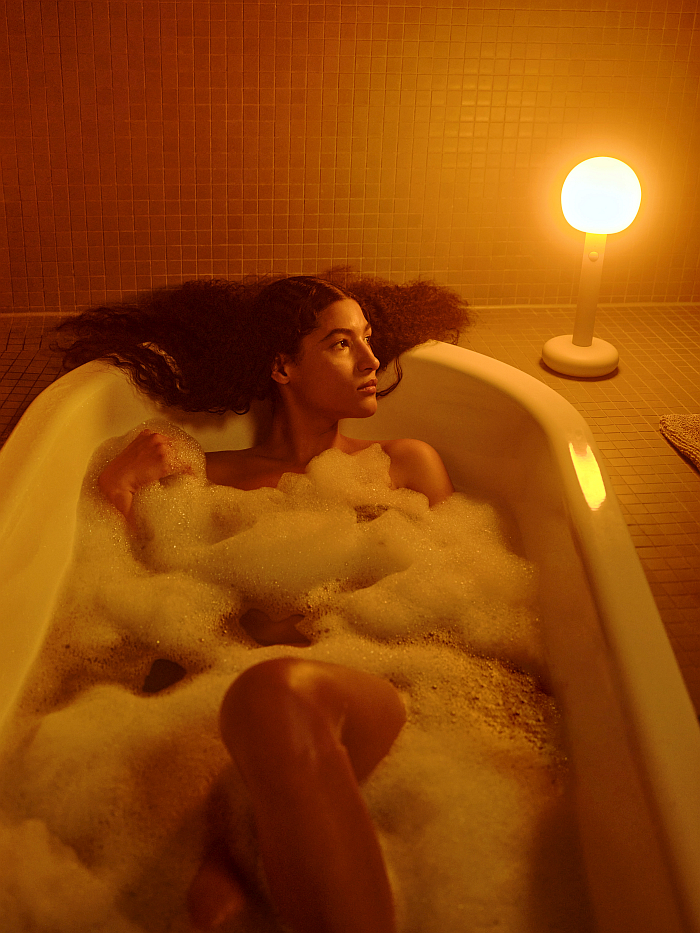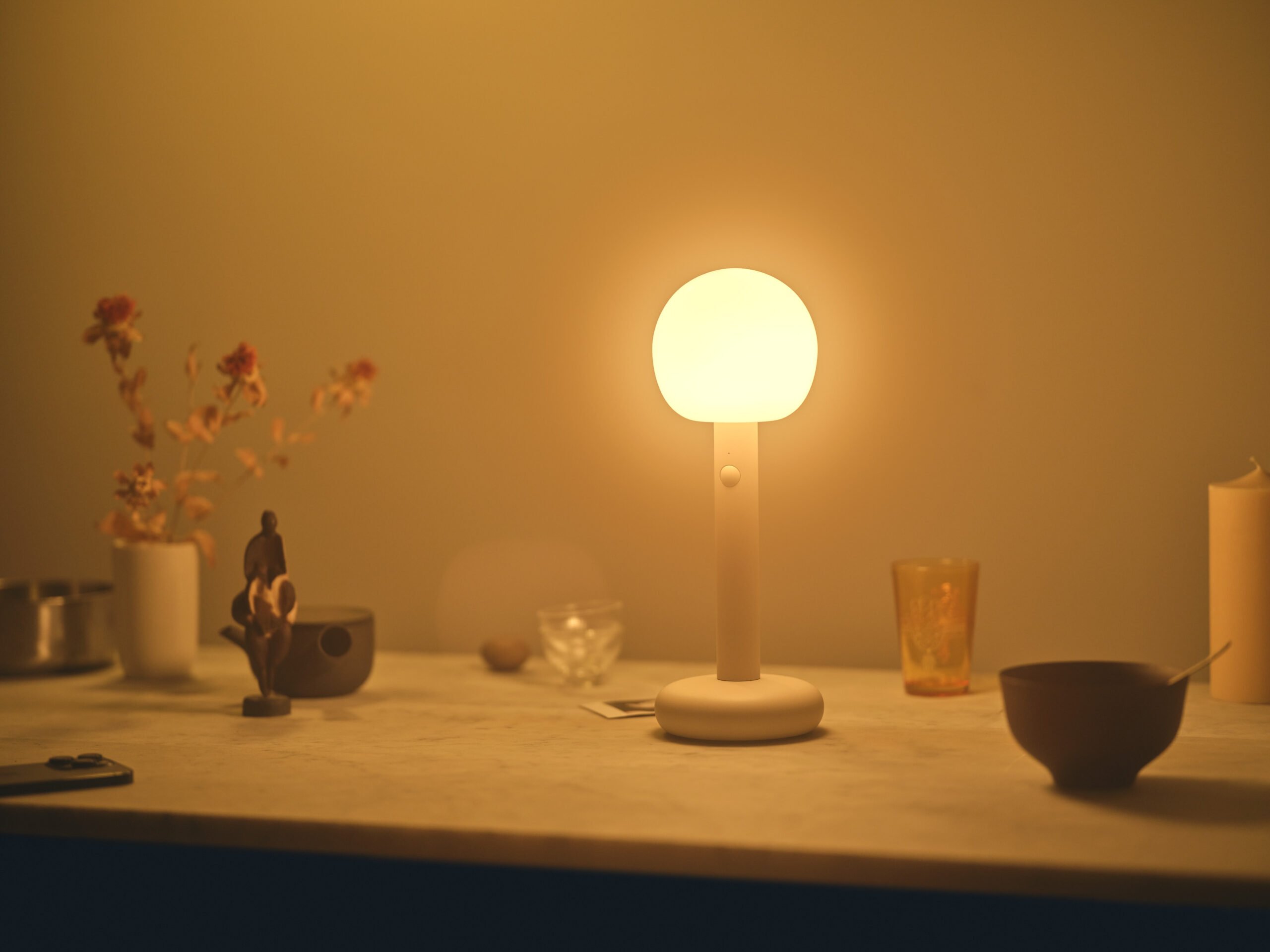Architecture | Designer | GRAU | Interview | Producer
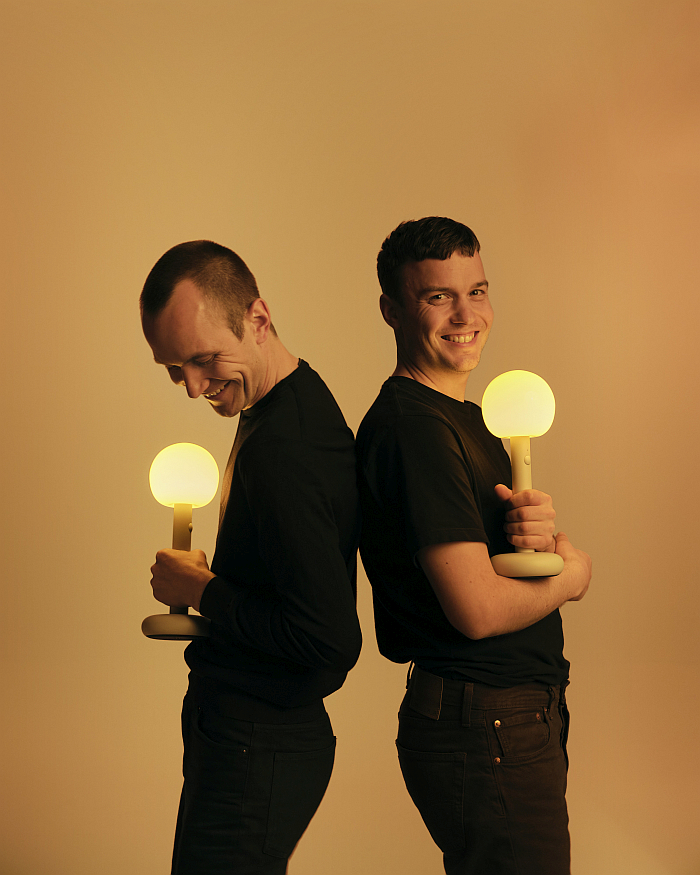
There is an argument to be made, one indeed we've often have made in these dispatches, that the (hi)story of human society, essentially, begins with the harnessing of fire, a harnessing that conceptually someone had to arrive at and which poses important questions as to how 'primitive' 'primitive' societies actually were: could you conceive harnessing fire, and then work out how to? We couldn't.
A harnessing of fire that was also a harnessing of light, that enabled our early forbearers to, at least in limited contexts, illuminate their spaces, and which over the centuries since has developed and evolved via, for example, the oil lamp, the candle, the arc lamp, and the incandescent light bulb to our contemporary LED technology; developments in lighting technology that have contributed to, influenced, informed and enabled the development of human society and culture over those centuries, allowing as it has us to not only illuminate our homes but to illuminate our streets, our factories, our shops, our offices, our theatres, our bars, our trains, our cinemas and which as LED technology (em)powers our contemporary networked digital devices. If, as noted from and discussed in, Uneversum: Rhythms and Spaces at the Estonian Museum of Applied Art and Design, Tallinn, our smartphones, tablets et al are also one of the sources of our contemporary malaises, not least contemporary society's chronic sleep problems on account of our doom scrolling and messaging in bed. And also through the blue light spectrums emitted by the LEDs in our digital devices that inhibit production of the sleep inducing hormone melatonin. As do the LEDs of LED lighting. A near textbook example of benefits bringing problems, of those things that contribute to, influence, inform and enable the development of human society and culture over the centuries also bringing fresh challenges for human society. See also the incandescent light bulb. And the arc lamp.
But what if you had blue light free LEDs?
And what if you could conceive harnessing fire?
Would you know what to do?
Rellingen, by Hamburg, based lighting manufacturer, GRAU had and have a few ideas.
As they always have.
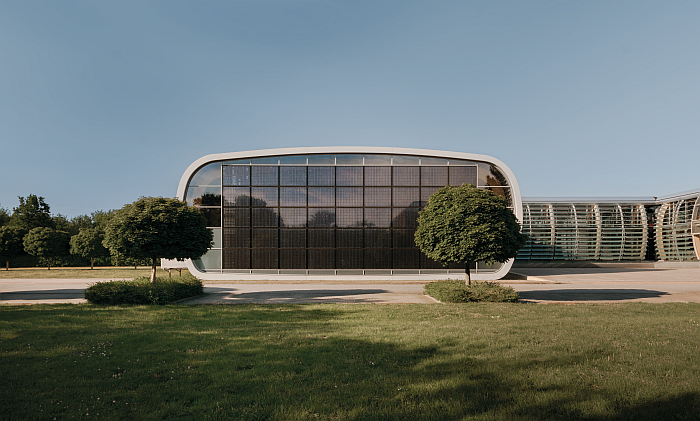
The (hi)story of GRAU, essentially, begins in the wilds of early 1980s New York where Hamburg native Tobias Grau enrolled at Parson School of Design, and picks up speed on Tobias's return to Hamburg and his establishment in the city of an eponymous interior design studio, which in 1987 became the lighting manufacturer Tobias Grau.
A company managed by Tobias and his wife Franziska which in the 1990s made the short move north from Hamburg to Rellingen, setting up home in a purpose built facility, a campus, designed by Hamburg based architect Hadi Teherani, and where since 1997 all (Tobias) GRAU products have been developed, designed and assembled. A GRAU Campus whose arched glassed southern facades are adorned, one could almost argue decorated, ornamented, by some 179m of photovoltaic modules, much as the facades of more religious buildings are often adorned with stained glass; photovoltaic modules whose carefully considered spacing allows daylight through yet not only provides for sun protection in the interior, but the use of that protection as a source of energy. A further 128m of photovoltaic modules on the western building adding to the power generation capabilities of the GRAU campus, and not only standing as an early committent to resource efficiency at GRAU, but also demonstrating how photovoltaic modules can be integrated into architecture, can be a component of architectural design, rather than being an addition to architecture. A commitment to resource efficiency and novel technology that can also, we'll argue, be understood in Tobias and Franziska Grau's switch in the early 2000s to LED technology for all their lighting, and that as one of the earliest adopters, certainly in Germany, of a still very much developing technology.
A company managed by Tobias and his wife Franziska which over the decades developed into one of the more important and interesting European lighting manufacturers; a company whose works not only grace private homes but have been, are, employed in and for numerous international architectural and interior design projects, including that for Q's laboratory in the 2012 James Bond film Skyfall: the lamp Bill by Tobias Grau gracing all the desks of the British Secret Service's most important product development team. Which may, arguably, also be metaphor for the nature of the innovative, pioneering, research work undertaken on the GRAU Campus. If research work at Rellingen more concerned with the meaningful illumination of human spaces than getting secret agents out of improbable pickles of their own making.
And a company who in 2021 Tobias and Franziska passed control of to their sons Timon and Melchior; a generation change that not only saw a rebranding in Rellingen but also saw responsibility for the development of the GRAU portfolio and for GRAU design pass to Timon and Melchior Grau.
And thereby to a partnership forged in the course of joint art studies at first the Universität der Künste Berlin under the likes of Ai Weiwei or Hito Steyerl, subsequently at the Städelschule Frankfurt under Willem De Rooij, and for all in the development of a joint artistic practice encompassing both physical objects and conceptual performances, installations and interventions, including, for example, the Messenger series with its reflections, literally, literarily and conceptually, on communication in our digital age; Uncanny Human, a work that could be a chair, mustn't necessarily be a chair, but which does ask you to question if it isn't a chair what is it, what is a chair and how do chairs relate to humans, how do humans relate to chairs?;Time is Only Movement, a performance in Athens which saw the brothers walk randomly through an exhibition space for three weeks; or Bonfire a 2.5 metre diameter digital LED campfire that premiered at Bergen Assembly Triennale 2022 and a work, we'll argue, that not only encompasses, summarises, encapsulates many of Timon and Melchior's considerations and questioning of light in recent years, but whose genesis, whose coming, can be retrospectively understood in much of what came before. Can't be predicted by the previous works, but once there, a path can be traced back through them.
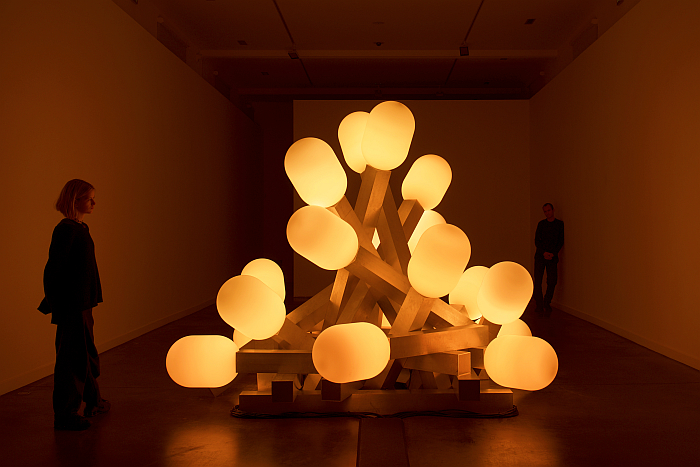
An artistic practice, artistic research, exploration and questioning, that stands very much at the forefront of not only Timon and Melchior's design but the motivation for their design, the genesis of their design, the genesis of that which they seek to achieve and contribute with their design, as can be understood in and via projects such as Parrot, Salt and Fire, works which also express the influence of artists such as, and amongst others, Alberto Giacometti, Jeff Koons, Mark Rothko, or untold Flemish Masters, the latter two existing in Fire in a unity that art (hi)story couldn't arrive at, refuses to accept exists, and reflections on the artistic practice of others in their functional objects that echoes the brothers' translation of their artistic practice into functional design.
And a contribution of Timon and Melchior's speculative artistic research and practice to the functionality of their design that can also be understood in concepts such as Sunset Dimming or Vibes: the latter a light that can very much be understood in context of Bonfire, and Vibes that are a key component of Fire, a work that is an utterly charming interplay of an industrial aluminium body and an artisan mouth-blown glass head, whose use is as intuitive as the flambeau of yore; the former, and summarising more than is prudent, or can do the concept justice, a capturing of the slowly setting sun in an electric lamp that is very much at the heart of Timon and Melchior's most recent works. And both Vibes and Sunset Dimming, innovations which bring the movement and vitality of natural light to the static monotonality of electric light; which, if one so will, capture natural light in a meaningful form much as our earliest forbearers once captured fire.
A capturing of light in a meaningful form that can also be understood, if in different contexts, in the brothers Tube series, an agile family of (home) office lamps who not only coordinate physically but who communicate as a family; who provide simultaneously for direct and indirect illumination, for a direct practical illumination and an indirect atmospheric illumination; and whose defining feature is the Beam Lens technology that allows a limited number of compactly placed LEDs to evenly illuminate an entire desk surface with a variable glare-free light. Which is a very neat trick we think Q would be impressed with. And Tubes that are and were the brother's first series, that so important component of any and every furniture and lighting manufacturers portfolio.
And thus a collection of lamps developed by Timon and Melchior Grau that stands not only symbolic for both the continuation at and of GRAU under Timon and Melchior and also of the generation change at GRAU but also programmatic for the approaches and positions of Timon and Melchior. And indicative of where GRAU may continue under Timon and Melchior.
Keen to know more, we met up with Timor and Melchior at the Grau Campus to talk about Parrots, Fires, Salts, Sunsets etc, but began way back at the beginning and their relationships with the company as children, the relationships of the family business to the business of family......
Timon: GRAU has been part of our lives for as long as we can remember. We grew up with the company and not only always had a close exchange with our parents about what was happening at GRAU, but our father involved us early on in his design process, shared his designs with us, asked for our opinions and discussed his designs with us.
smow Blog: And thus was it always clear that one day you would take over the company, or...
Melchior: ...that wasn't clear, but we were always very close to the company. After graduating from high school we moved to Berlin and started painting, studied art together, and during that time we started staging exhibitions, creating sculptures and performances, building an artistic work as an artist duo. And then from a performance in Athens the Parrot lamp arose as an idea, that then became a lot more, and through Parrot, we learned about product development, had to ensure production, produce campaigns, and suddenly we were in the middle of it all...
Timon:...and interestingly, we have rediscovered the medium of light for ourselves and understood what a special medium light actually is. How light shapes people's every moment.
smow Blog: There are a couple of points in all that we'll come back to shortly, but taking a step back: given your childhood and the ubiquity of the company and its products, why the decision to study art and not design?
Melchior: For us art is a powerful inspiration and stimulus for critical thinking. We use design and entrepreneurship as a means to an end, to realise visions and create change; behind this is the conviction that critical thinking and a sensory sensitivity must be cultivated and that pragmatic tools are needed to bring them to life. We have great respect for design, it is highly complex, no question about it, but for us it is a means to an end for the positions and contribution that one wants to make. It is easier to have a clear position and a clear vision and then learn the tools that one needs to achieve them, than the other way around, to be able to use the tools but to have no position, and thus not to know what to do with those tools.
Timon: Being an artist is a commitment to the values we want to stand for. Studying art means developing and strengthening the position one adopts and also developing a form of expressing that position.
smow Blog: Which brings us back to Parrot. Its origins were and are, as you said, in context of your performance Time is Only Movement in Athens. Was there an active plan to develop a lamp, or how does Time is Only Movement become a, the, Parrot?
Timon: In Athens we walked through the empty exhibition space for three weeks and the visitors watched us as we walked around and through them, we were interested in the interaction between us and the viewers: how do people look at people? How do people look at movement? How does this relationship change? We didn't speak for the entire duration of the exhibition and then on the last day, simply in the moment, we started talking about the idea of a sculpture that has the shape of a human figure, moving dynamically through the space and transforming the space with its presence and light...
Melchior: ...shortly afterwards we began work on the Parrot, we showed Tobias the design and he liked it straight away, he was also very supportive, it was a great dialogue, and then a few months later Parrot was presented at a trade fair. The product wasn't really finished yet, but the idea was there. At the same time, we developed Salt & Pepper, the predecessor to Salt, with Tobias, and these were the first mobile lights on the market, which was an important innovation for the entire lighting industry...
Timon: ...the two lights were also very successful very quickly, which helped us with the change process and the generational handover, accelerated it.
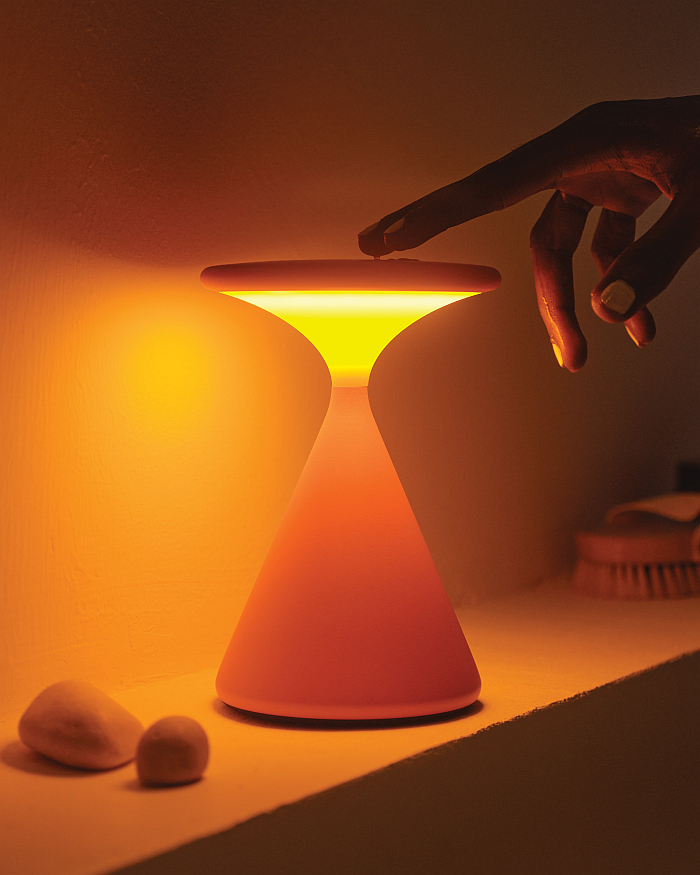
smow Blog: With regard to this change process and generational handover, you mentioned earlier what an important medium light is, how light shapes and influences people, etc. If we look at your work in the context of your father's work, is part of this generational change process also a move away from a more technical light towards an atmospheric light, from a technical functionality towards an emotional functionality?
Melchior: It's more a shift of focus than a fundamental change. We have a great heritage that Tobias and Franziska have built up, and we continue to cultivate this important core to this day, especially the sculptural design and the high quality of workmanship. The sensuality of the light has always been there, but you're right, we've increased the focus on that, we want to create lighting moods that really touch you.
Timon: Through Sunset Dimming our light has a health effect. The influence of light is crucial for mental health and well-being, and Sunset Dimming creates a light similar to the sunset, which has a calming effect on the body and mind. The latest studies show that warm light in the evening has a significant impact on health, the warm Sunset Dimming light contains no blue component and is therefore proven to be beneficial to health.
smow Blog: Hold that thought, we'll come straight back to it, but one of the things that interests us about your work, and which is also a component of the question of technical functionality and emotional functionality, is the way in which you use technology, not as it has perhaps been understood in recent decades to enable a perfectly white light, to generate a light to illuminate a room in the bright, white light, but rather you use it to make light an active part of a room, you use technology to let light be what it was before technology made it something else. Your light is more of a primal light...
Melchior: ......we really like that, the archaic, and that is also the future, we describe Bonfire as a point of contact between the past and the future. For the users of our products, it is often not so obvious what effort is involved making certain experiences possible, but it feels different, is intuitive and special and that experience is what our work seeks to achieve. It's gratifying if one reason to buy GRAU is that the light feels different.
smow Blog: An important component in making such experiences possible is LED technology, GRAU was one of the first lighting manufacturers, at least in Germany, to switch to LED technology, LED technology is important for your work. Is your understanding of light to a degree influenced by LED technology?
Timon: LEDs and the digitalisation of light offer a huge range of possibilities. We always start from the sensory experience of light, for example, we look at how light in nature affects people, the sun and fire are important inspirations for us, and then we use technology to create meaningful and valuable experiences that have never existed before and that offer added value for individuals. So technology is a very important means to an end.
smow Blog: Which brings us back to Sunset Dimming, was Sunset Dimming a project that was already in the pipeline before you took over the company, or one that originated with you?
Timon: The research goes back quite a long way, but not in the concreteness that we see today, so there were previous developments that we used to develop Sunset Dimming. In recent years we have focused on the biological and stimulating effects of light colour, whereby our art exhibitions were important experiments.
smow Blog: That's a great bridge, thank you! In a few of your exhibitions, we are thinking especially of 'I think of touching sharp objects as if they think of touching me' or 'Don't Fuck with the User', an important, recurring aspect, a core consideration, is the relationship between object and human, in 'Don't Fuck with the User', for example, you write, 'If the environment is only designed to meet our needs - and we no longer know its natural state - how much control do we still have over ourselves?' If a lamp brings light conditions from outside to inside, do we still have control over our interior spaces? Shouldn't we be able to distinguish between inside and outside?
Melchior: It's true that we spend a lot of time thinking about how our environment affects people, and I also believe that we cannot escape our relationship with design, because it is what makes us human: we are constantly trying to shape our environment and the environment shapes us in return. This is also a responsibility of design, to consciously shape the environment in such a way that it makes a positive contribution and feels good. Light plays a huge role in this...
Timon: ...and that's been the case since the campfire, and in an age now when people spend a lot of time on their phones, when we perhaps meet less than before, the live moments are becoming all the more crucial. Light gives these moments vitality and brings people together: the workplace has to feel good so that we come together, and light turns dinner into a sensual and social experience. We see our lights as a digital detox, as a reflection on the haptic space, coming together and sensing, ideally with others.
smow Blog: To finish, a quick look ahead, you have now arrived, have relaunched the company, redesigned the HQ, etc... In context of the GRAU portfolio, can you give us any clues on how that may, possibly, develop in the coming years?
Timon: We can readily imagine collaborations with artists, we have many artist friends with whom we are in regular dialogue and enjoy working together, but we also find collaborations with other brands interesting. But ultimately every GRAU product design comes from us and our team.
smow Blog: And what can we all expect next from, for, GRAU?
Melchior: Fantastic new stores! We're starting with Pop-up stores in Hamburg and Berlin in the autumn and then we'll be opening new flagship stores in both cities next year. We're designing the stores and there will be strong lighting experiences therein.
Timon: They will be places where you can immerse yourself in and learn about light. With the stores we want to show people new perspectives on light, how light influences their lives and their feelings.
We're looking forward to experiencing what that all means, and for all where your research takes you in the coming years. Thank you for your time!
